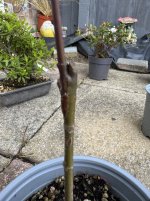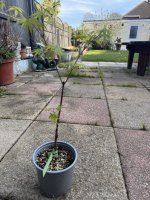Hi all. I recently picked up my first Deshojo and Arakawa maple from a specialist maple nursery (not a bonsai one). I've never really cared for a maple before, so was just wondering if anyone had any tips specifically or could link to some good resources about them? These are the ones in question:
Deshojo:


Arakawa:


Will the tree eventually grow to a point where the grafts will be less visible? Or should I just opt to use these two plants as mother stock to take air layerings from etc. and develop that new material? And in terms of just letting it grow and thicken, is the best thing to do just to leave it and not touch it or maybe give it a light prune at a certain time? I think I will start feeding them now.
Deshojo:


Arakawa:


Will the tree eventually grow to a point where the grafts will be less visible? Or should I just opt to use these two plants as mother stock to take air layerings from etc. and develop that new material? And in terms of just letting it grow and thicken, is the best thing to do just to leave it and not touch it or maybe give it a light prune at a certain time? I think I will start feeding them now.
